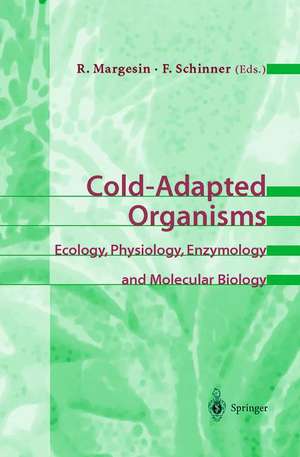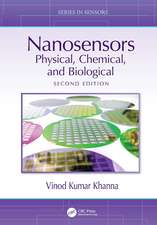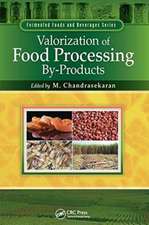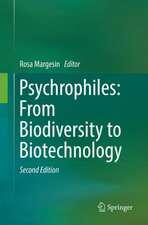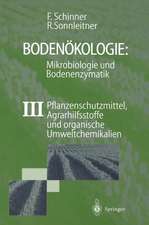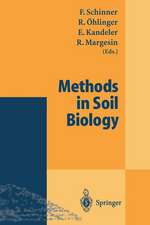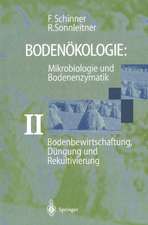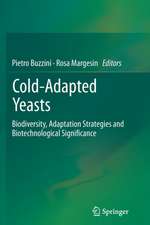Cold-Adapted Organisms: Ecology, Physiology, Enzymology and Molecular Biology
Editat de Rosa Margesin, Franz Schinneren Limba Engleză Hardback – 5 mai 1999
| Toate formatele și edițiile | Preț | Express |
|---|---|---|
| Paperback (1) | 1047.49 lei 38-44 zile | |
| Springer Berlin, Heidelberg – 5 dec 2010 | 1047.49 lei 38-44 zile | |
| Hardback (1) | 1229.10 lei 43-57 zile | |
| Springer Berlin, Heidelberg – 5 mai 1999 | 1229.10 lei 43-57 zile |
Preț: 1229.10 lei
Preț vechi: 1498.90 lei
-18% Nou
Puncte Express: 1844
Preț estimativ în valută:
235.19€ • 246.18$ • 195.75£
235.19€ • 246.18$ • 195.75£
Carte tipărită la comandă
Livrare economică 31 martie-14 aprilie
Preluare comenzi: 021 569.72.76
Specificații
ISBN-13: 9783540649731
ISBN-10: 3540649735
Pagini: 428
Ilustrații: VIII, 416 p. 22 illus.
Dimensiuni: 155 x 235 x 32 mm
Greutate: 0.77 kg
Ediția:1999
Editura: Springer Berlin, Heidelberg
Colecția Springer
Locul publicării:Berlin, Heidelberg, Germany
ISBN-10: 3540649735
Pagini: 428
Ilustrații: VIII, 416 p. 22 illus.
Dimensiuni: 155 x 235 x 32 mm
Greutate: 0.77 kg
Ediția:1999
Editura: Springer Berlin, Heidelberg
Colecția Springer
Locul publicării:Berlin, Heidelberg, Germany
Public țintă
ResearchDescriere
Major parts of the oceans and lands of our planet are permanently, or temporarily, exposed to temperatures below 10 C. Microorganisms, plants and animals living under these conditions have adapted to their environments in such a way that metabolic processes, reproduction and survival strategies are optimal for their natural biotopes. This book presents the most recent knowledge of the ecology and the physiology of cold-adapted microorganisms, plants and animals, and explains the mechanisms of cold-adaptation on the enzymatic and molecular level, including results from the first crystal structures of enzymes of cold-adapted organisms.
Cuprins
Ecology and Physiology. Cold-Adapted Microorganisms. Microbial Life in Permanently Cold Soils; Lake Ice Microbial Communities in Alpine and Antarctic Lakes; Physiology of Cold-Adapted Microorganisms. Cold-Adapted Plants. Ecological Aspects of Cold-Adapted Plants With a Special Emphasis on Environmental Control of Cold Hardening and Dehardening; Plant Responses to Low Temperature: Signaling Pathways Involved in Plant Acclimation; Ice Nucleation and Deep Supercooling in Plants: New Insights Using Infrared Thermography: Modeling Sequential Responses of Plant Cells to Freezing and Thawing. Cold-Adapted Animals. Cold Adaptations in Terrestrial Invertebrates; Nival Invertebrate Animals in the East Alps: A Faunistic Overview; High Alpine Streams: Cold Habitats for Insect Larvae; Ecophysiological and Morphological Features of Glaciar-Dwelling Collembola; Ecological Features of Antarctic Fishes; Structure and Function of Hemoglobins From Antarctic Organisms: The Search For Correlations With Adaptive Evolution.- Enzymology. Cold Enzymes: A Hot Topic. Psychrophilic Enzymes: Insights Into Cold Adaptation and Catalysis From the First High Resolution Crystal Structures. Temperature Adaptation in Enzymes of Antarctic Fishes. Aspartate Aminotransferase From Moraxella TAC125: An Unusual Psychrophilic Enzyme.- Molecular Biology. Genes and Enzymes Involved in Argininge and Pyrimidine Biosynthesis in Psychrophilic Vibrio Strains From the Deep Sea. Plasmids From Antarctic Bacteria. Molecular Responses in Cold-Adapted Plants. Gene Expression and Cold Hardiness in Animals.-
Textul de pe ultima copertă
Major parts of the oceans and lands of our planet are permanently, or temporarily, exposed to temperatures below 10 C. Microorganisms, plants and animals living under these conditions have adapted to their environments in such a way that metabolic processes, reproduction and survival strategies are optimal for their natural biotopes. This book presents the most recent knowledge of the ecology and the physiology of cold-adapted microorganisms, plants and animals, and explains the mechanisms of cold-adaptation on the enzymatic and molecular level, including results from the first crystal structures of enzymes of cold-adapted organisms.
Caracteristici
Large parts of our biosphere (oceans, high mountains) are permanentely colder than 10 C - how do organisms adapt to such cold environments?
